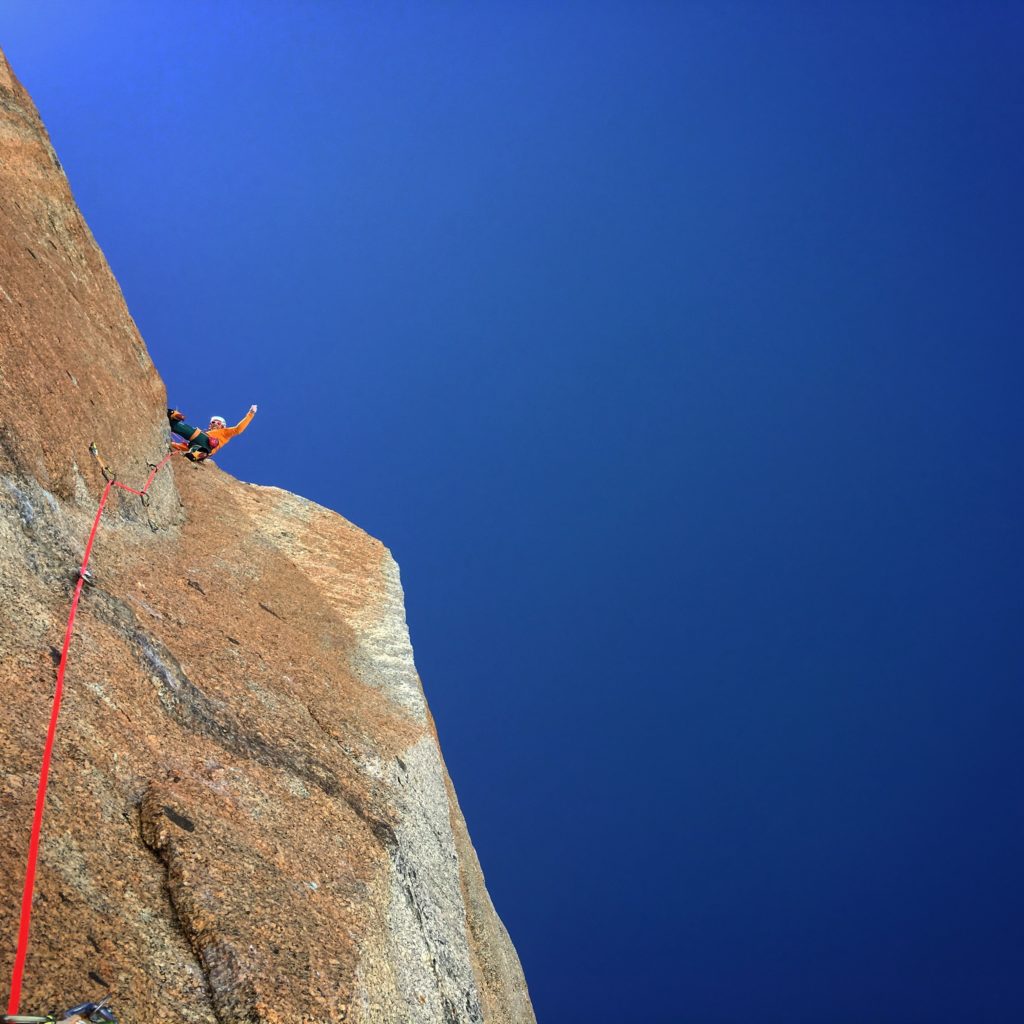The week in Chamonix began by getting caught in a storm, and ended the same way. The first one expected, the second one less so, but sandwiched in the middle was a couple of peaks that will make the week a memorable one.
The weather this summer in Chamonix has been changeable to say the least, quelle surprise, but it seems it’s been quite hard to find spells of weather forecast you can be confident enough in to make committing plans. It has been a summer season I’ve been training hard for; endless aerobic sessions in the wall, hour long fingerboard sessions, days and days of olympic rings and core, and plenty of setbacks including a pulley tear and broken ankle.
I arrived in Chamonix at the end of June, ankle somewhat capable, and finger thankfully healed only weeks earlier. Since March, I’d led one VS, seconded an E5 and fallen off an E5… so a season in Chamonix was a bit of a blast into the unknown, although with a tick list of over 20 routes, including Digital Crack, I needed to get going!
It was quite satisfying to jump straight into some of the shorter but challenging classics on the list: Le Ticket, Le Carre, Le Rond et La Lune, Mr de Mesmaeker and to test the ankle on a more scrambley storm racing ascent (and a huge whipper, ahem Rockfax) of the SW Ridge of the Aiguille du Peigne. After a couple of weeks of easing in, the weather was relatively stable, but with high winds. I’d spent a week back in the UK recovering and working, and my skin had just about healed after splitting both my tips on the first red-point attempt on Digital Crack so I was keen to crack on with a “peak week”.
Sunday – El Niño
There’s a route, appropriately called El Niño, in the Aiguille Rouge, that Piola describes in the new English version of the guidebook as: “Exceptional: this is one of the mythical crack-lines of the Mont Blanc massif”. I set about trying to find out about it, yet not a single person, Hazel Findlay, Eric Blanc, Tim Neill and more, I asked knew much about it, nor was there a picture or beta anywhere online.
So Rob Adie and I went to go check it out on a short weather day. 45m, 7b+ and no in situ gear; it starts 3 pitches up another route, La Leyenda del Doranda. The “approach” pitches themselves are worth seeking out, very UK style trad, one a peak style finger crack, another like an easier version of Trilogy in the Lake District. When we got to the top of the 3 pitches at lunchtime, El Niño arrived and the heavens opened, and so they did a number of times on the slippery descent back to the Emosson Dam.
So the crack remains mythical for now, but looks amazing, just like a huge Gogarth E5 in the sky.
As it turned out afterwards, I did know someone that knew something about it. Owain Jones (my now go to beta-man) watched the first ascent by Fabian Meyer and Michel Piola from La Balade des Gens Heureux.
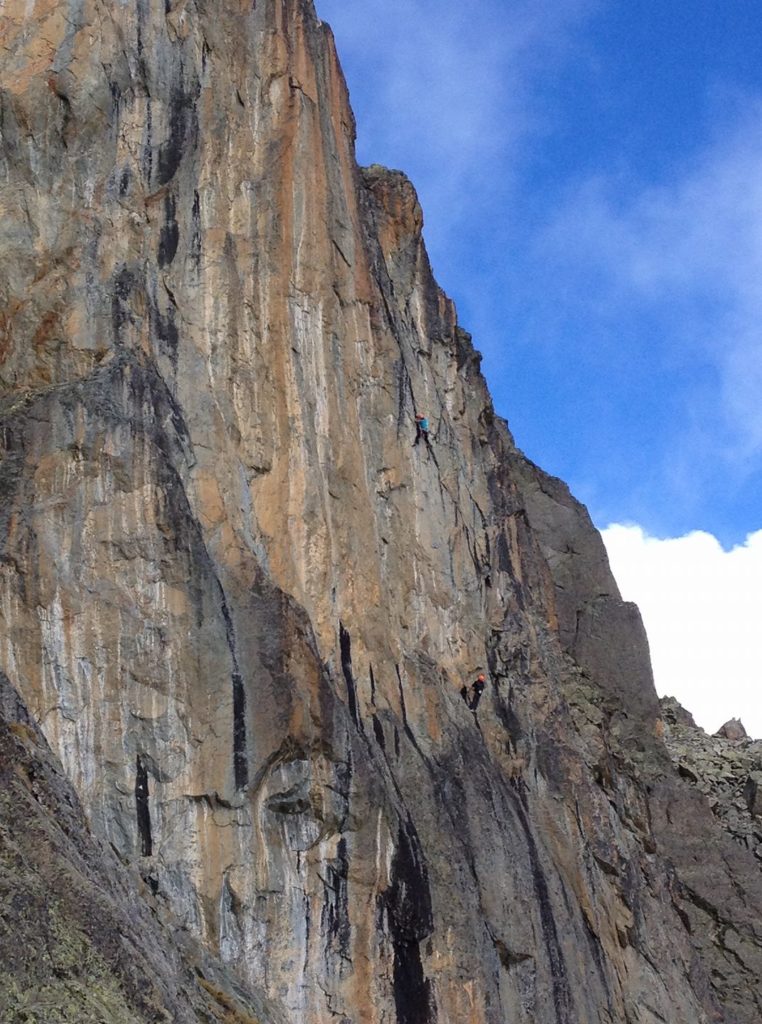
Photo Credit: Owain Jones
Madame Rêve – Tuesday
Whilst Ben Wolstenholme and I were climbing Le Ticket, Le Carre, Le Rond et La Lune, we’d had a very sociable ascent climbing parallel to the Swiss guide, and prolific topo writer, Eric Blanc. Eric was climbing Madame Rêve, a very similar but harder version of Le Ticket. Eric has an excellent, and free, topo site (http://chamgranit-topos.com/) to many of the classic granite climbs of the Chamonix valley. Eric’s an incredibly affable person, we exchanged emails, and as a result he recommended Madame Rêve to me.
Madame Rêve is a little known route, with 7 excellent pitches of fairly intense climbing. There’s quite a lot of sustained and run out friction climbing with a steeper 7c, or 6c/A0, crux. If you fancy it, it is excellent, but you’re going to have to be comfortable climbing 6c friction moves above the gear.
It was a whirl-windy day with strong south-westerly winds forecast, but I figured that the slabs would be sheltered by the Papillon Arête. I headed up there with Tim Oliver and Rob Adie, the intention was to have a go at free-ing the 7c pitch at the top. Confirming my suspicion that the Peigne would be sheltered, Eric Blanc arrived to climb the route next to us and I now felt I definitely had to pull it out the bag!
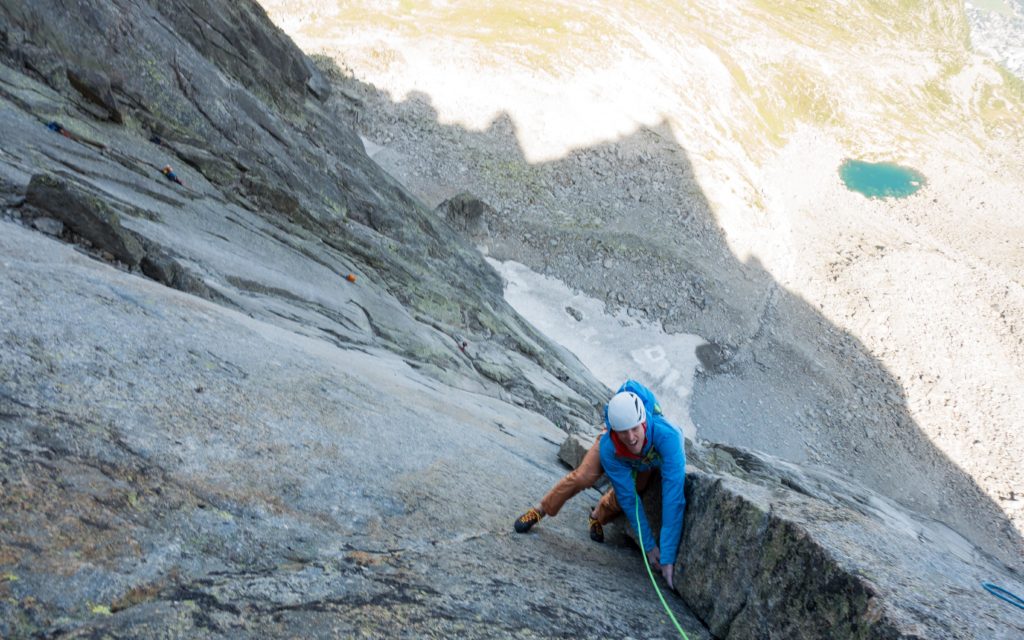
Tim headed up the first “6b” pitch. I knew Tim was a good climber, and 6b was well within his capabilities, but was slightly concerned when he handed over the lead at the first bolt! I climbed up to the first bolt and quickly realised that the first pitch was a definite “punch in the face to get going style pitch”, certainly under-graded and requiring a biblical faith in granite friction.
The locals and activists have been very active in the valley re-equipping routes recently, not least Michel Piola, though in this case, by equipped, if you’re a Brit, it’ll still feel like you’re on a 250m long and slightly alarming E5, with an even harder crux.
The 6th and crux pitch came after a number slightly nervy but fun pitches of 6c smearing.
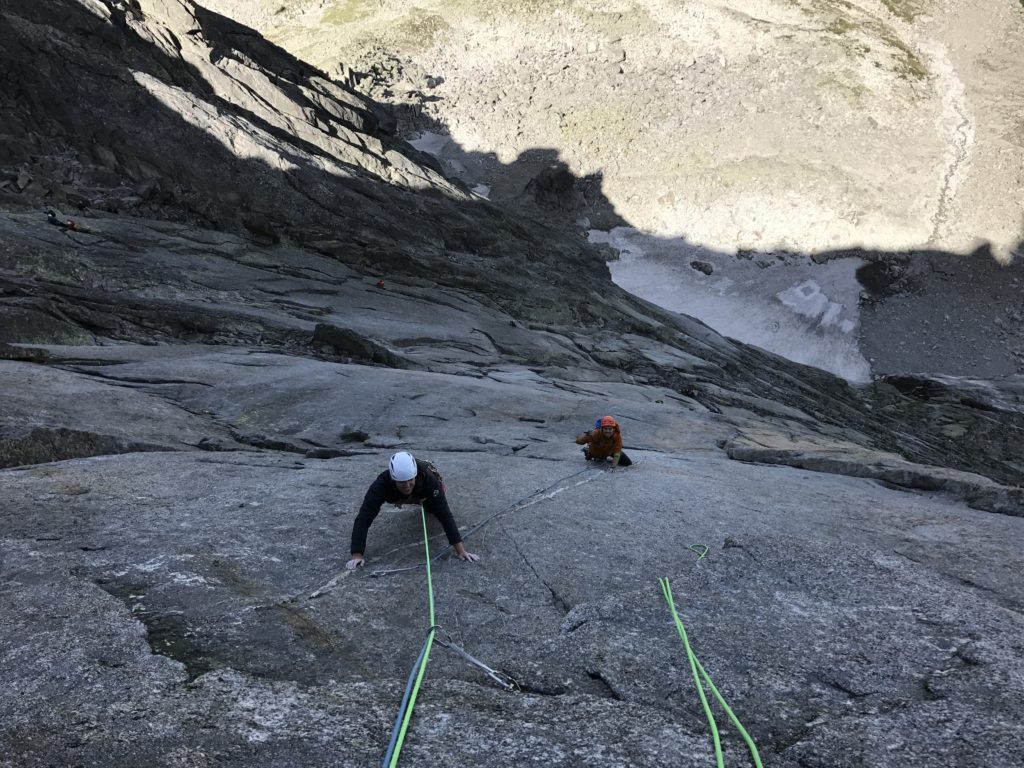
I had a flash go at the crux pitch, but got quickly thrown off by the technicalities of the slabby roof, or rather the complete lack of holds. I pulled up through to the next clip, found what felt like to be the hold at the end of the crux sequence and worked backwards. The crux sequence is a very techy, very smeary V6/7 mantle and rock-over, but with some funky balance moves and a shoulder high foot, it does go. I unclipped the bolt, lowered to the belay and went onto the red-point.
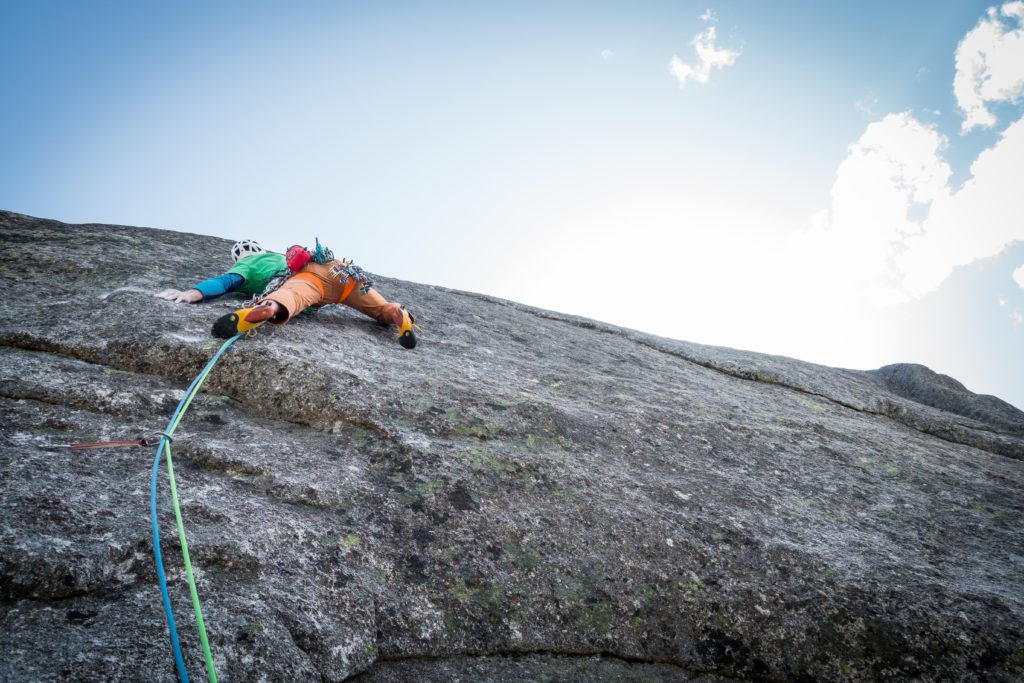
Photo: Tim Oliver
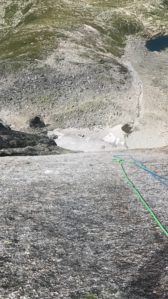
Psyched to gain the hold I’d identified as the end of the crux I carried on climbing, only to find, whilst somewhat easier, it definitely wasn’t over and I nearly blew it rocking over into a hands off rest by standing on some damp grass. Just like Le Ticket, the “easier” slab at the top was definitely not easy, the mental strain of not wanting to fall-off after 20m of run-out and exceptionally thin 6c slab, having fluked my way through the crux, was taking its toll. The very last move was a total heartbreaker, the angle of the slab had eased, but there were literally no holds, just a complete faith based set of smears to success (or a slow grating slab rash of failure.) I did that terrifying “smear lunge to a break” that you learn to do on the gritstone when facing a deck-out, and clipped the belay, taking a long moment to myself before shouting “safe”.
We’d set a turn around time of 2pm, and a bin time of 4pm as I had to be in Verbier for 6:30pm to meet Ray Wigglesworth about the BMC Organisational Review. With a drop of rain, we reached the final rappel anchor at 1:57pm, the Plan d’Aiguille at 3:58pm (with a 5 minute rest to gawp at the Mallory on the North Face of the Midi collapsing) and I arrived in Verbier at 6:29pm. The day had gone to the tick tock of a quartz driven Swiss watch.
Psychologically, although I hadn’t been training for granite 7c friction slabs, it was super helpful to have ticked Madame Rêve so quickly, given Bruce Marsh and I were off to the main event a day later.
Digital Crack – Thursday
Digital Crack, Europe’s highest 8a/+, has been one of the main foci of my summer in Chamonix. 16 years ago when I first arrived in Chamonix as a youth, like most folk, the Cosmiques Arete was the first route I ever did here. Being the ambitious (cocky) 17 year old I was, I looked up at Digital Crack, on the Great Gendarme, from the crux of Cosmiques Arete, thinking Digital Crack would go, someday. It’s an incredible line, undoubtedly one of the most aesthetic lines in the Alps. I initially put 4 days of effort in in 2016, although one of those was a complete write off.

Photo: Heather Swift
On day one, it was pretty clear it would go, but only after it had taken about 30 mins of hunting around for Bruce and I to find a critical hold on the crux. We’d also quickly worked out that conditions were everything, the route gets the blazing sun until about 1pm in summer. One go in direct sun, and it’s likely your tips are bleeding. Hazel had warned me that the crux was sharper than a bag of biting weasels, and she wasn’t wrong.
Bruce is great fun to climb with, and managed to send Digital Crack on the second day. We’d rank our chances of success each day based on conditions, skin, acclimatisation etc. I’d just had my first proper red-point and I fell right at the end of the crux. Bruce ranked my chance of success of the next go at 70%, telling me to have a 5 minute rest. In the meantime he’d have a quick go because he felt he’d fall off mid-crux. Bruce left the belay, and having nearly fallen off the 6c approach pitch, he rated his chances of at 20%. We’d both managed to do the crux sequence by then in isolation and somehow, on pretty much his real first red-point go Bruce wobbled through it. Wholly un-prepared for the remaining 20m of 7b/7b+, over the next 30 minutes Bruce’s wobble increased proportionally to his decreasing chances of success. Somehow Bruce grabbed the final jug with 1% chance of success left, lowered off and apologised for stealing my red-point. I hadn’t put on my jacket, had completely cooled down and fell off only a couple of moves from the belay on my go, though completely psyched that Bruce had got his tick.
I had a couple more days on it, but never felt good, either splitting my tips, or falling after the crux as snow melted down the groove, with the snow from the September storms.
Red-pointing a route is a process of iterating failure towards success: test and learn, but don’t give up. This year I knew we’d need a cool day, ideally overcast, an opportunity to warm up properly, with a full set of finger skin and to be fully acclimatized. I’d headed up in early July, put my clips in, ignored my own beta, tried to red-point in the heat of the day and split both my index fingers open, meaning at least 2 or 3 weeks before the next attempt. I’d also changed one tiny thing, wearing La Sportiva Otakis instead of the Genius. Although not a shoe suited for incredibly technical micro smearing, it seemed to make a huge difference.
I also noticed one huge difference this year. A year of core and fingerboard training had meant I could do the crux ever so slightly differently, it was subtle, but it reduced the odds of failure significantly. Perhaps breaking an ankle was a blessing in disguise, but I was terrified of falling off and hurting my ankle again. The crux is remarkably run out (for a bolted route), and finding an easier way of doing the crux helped a lot.
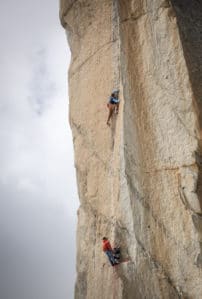
Photo: Dani Arnold
On the Thursday, high winds were forecast with very warm temperatures. However, Bruce had taken the day off work and I thought that Digital Crack would be sheltered by the wind direction. I woke up late, opened the blinds and to my surprise saw an overcast day. Great! Arriving at the midi station at 9am, the queue was huge, 3 hours said the Midi staff. The midi had opened only minutes earlier due to high winds. Disappointment set in until I spotted a friend, Dani Arnold toward the front of the queue. Dani had just come back from a trip to Pakistan and wanted to have a go on Digital Crack, and spend some time climbing with his wife! I cheekily snook into the queue with Dani and caught up with him, whilst waiting for a characteristically late Bruce, who arrived just in time. The counter staff handed us 4 passes to the next bin with a cheeky smile; we knew we’d skipped a huge queue. Luck was back on our side.
Approaching Digital Crack it was clear that conditions were perfect, and the Gendarme was sheltering the wind on the South side. We climbed the first pitch to the belay. Bruce hauled up a finger board to the belay. I put on my La Sportiva Genius shoes, ignoring my own advice, and had an awful time warming up on the route, climbing bolt to bolt, chalking 30m of tiny sequential holds. I clipped the top quickdraw, lowered off, changed my shoes, and then top roped from 2 moves above the belay to the top. The shoes and conditions made all the difference. I lowered off, pulled the rope, took a couple of minutes, did Patxi’s trademark fingerboard warm up, and set off on the red-point.
As I climbed through the crux I was still nervous about falling off. Having ignored the extended clip, I caught the small finger jug after the crux, went to clip, and with a huge loop of slack my foot popped. I stopped about 3m past the belay, having fallen about 10m, with Bruce jammed in the first quickdraw. Another whipper to add to the collection! I hauled myself back to the belay and couldn’t decide whether to go down and rest, or have a short rest and have another go. Bruce, a particle physicist at CERN, had now rated my probability of success at 80%.
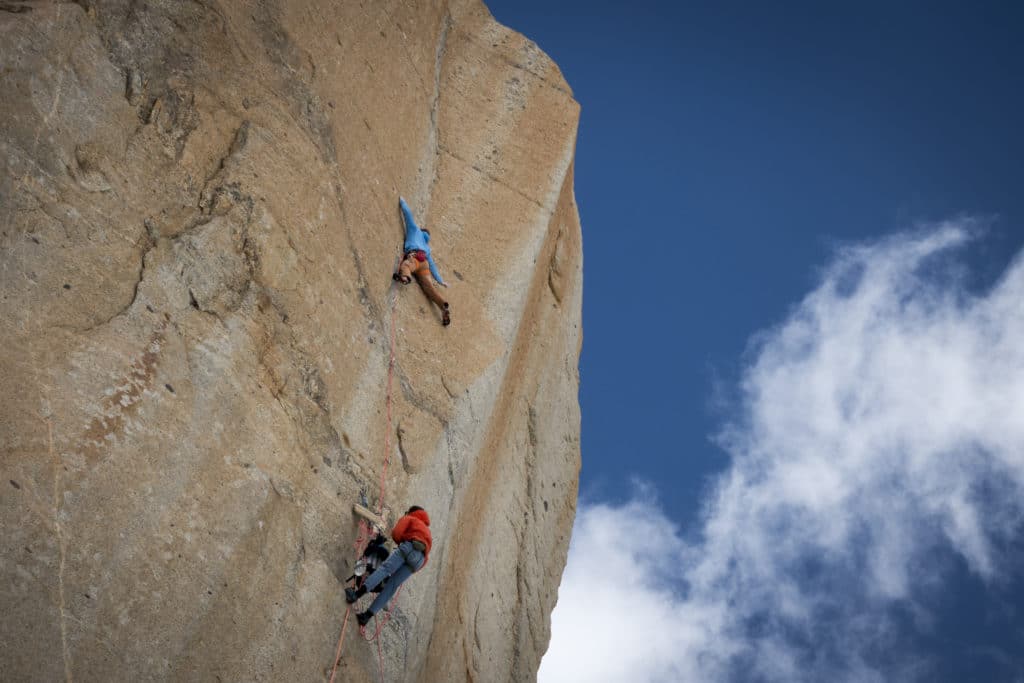
Photo: Dani Arnold
Dani was waiting patiently to have a go, and I shouted down to ask if he wanted to come up while I rested. He looked at me as if to say, just go, you’re mad not to try again.
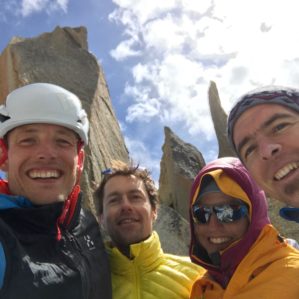 Climbing is as much mental as it is physical. Although now somewhat tired, the fear of falling and hurting my ankle was gone, and I would have been mad not to go again. This time, relaxed, I got through the crux, easily made the clip, and found the insecure hands off rest after the crux. Each sequence after that is progressively easier, and if you’re perfect with your feet, there are many opportunities to rest with just a small thumb press or a mono-gaston. However, from each marginal rest you have to leave it into a very insecure sequence, before the next breathing point. Mentally, it’s pretty draining, physically, the altitude bites. I grabbed the final jug feeling like I’d sprinted a vertical km and topped out onto the Gendarme. Mont Blanc might be 1000m higher, but that Gendarme felt like the top of the world.
Climbing is as much mental as it is physical. Although now somewhat tired, the fear of falling and hurting my ankle was gone, and I would have been mad not to go again. This time, relaxed, I got through the crux, easily made the clip, and found the insecure hands off rest after the crux. Each sequence after that is progressively easier, and if you’re perfect with your feet, there are many opportunities to rest with just a small thumb press or a mono-gaston. However, from each marginal rest you have to leave it into a very insecure sequence, before the next breathing point. Mentally, it’s pretty draining, physically, the altitude bites. I grabbed the final jug feeling like I’d sprinted a vertical km and topped out onto the Gendarme. Mont Blanc might be 1000m higher, but that Gendarme felt like the top of the world.
République Bananière – Friday, Saturday AND Sunday
No time for too much celebration, with a long tick-list and wanting to make the most of the good weather, Tim, Ben and I set off for République Bananière on the Aiguille de la République the following afternoon. A morning spent catching up on emails and bottling the home brew, followed by a nice easy walk in to bivi below the route. A few drops of rain on the approach signalled the shape of things to come.
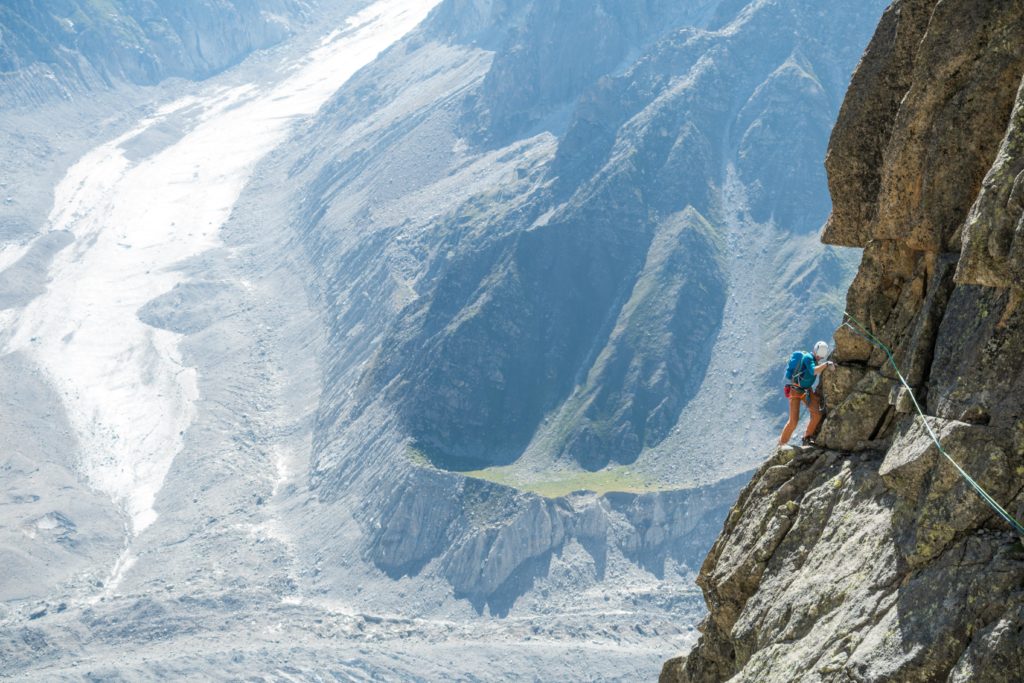
Photo: Tim Oliver
We set off to the base of the route in the morning, satisfied that the forecast had removed the potential storm that had been on the previous evening’s forecast, and that the following day would be probably be precipitation free too.
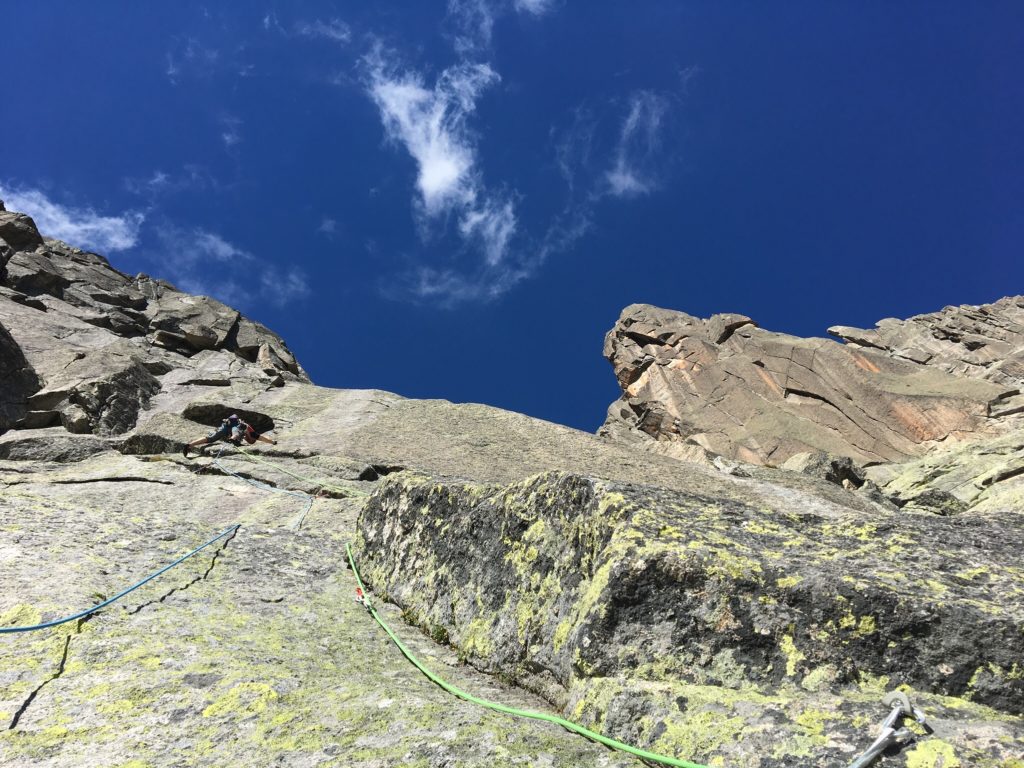
The route is 25 pitches of amazing granite slab and crackery, with the crux block of pitches right at the top. It then meets the normal route for the final couple of pitches. Very reminiscent of the Westgrat on the Salbitschijen, but harder (like an E4 version), with bigger pitches and a much more involved descent.
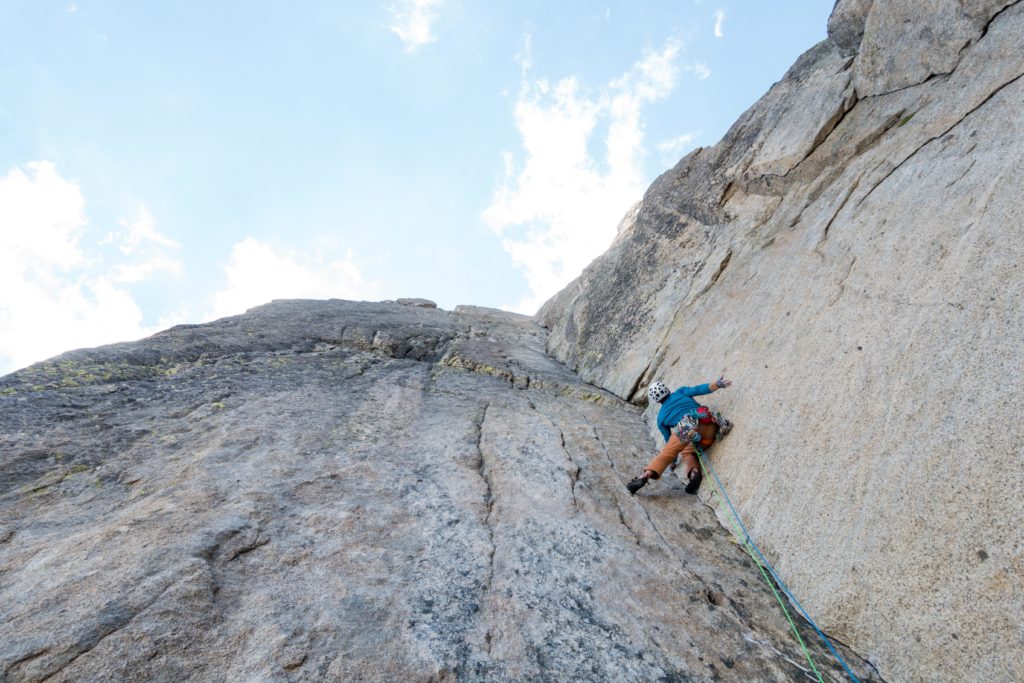
Photo: Tim Oliver
The gods were cruel, it started raining at pitch 23.8 and then clapped thunder at pitch 23.9. So no summit, by a hair’s width. The summit of the Aiguille de la République is no place to be caught in a storm. After the initial downpour the PGHM buzzed us, just to check who was up in the rescue hotspots. It gave me an inkling of what might be about to come.
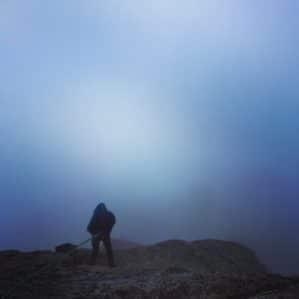
Although the storm wasn’t too severe, it rained and hailed and it made descending far trickier than otherwise. The sensible route off was to abseil the line of ascent, not to take the normal route. So we abseiled lots of complex diagonals, with some short pitches of climbing to reach the next anchors. Then it went dark, then we abseiled a lot more, then my head torch ran out of battery midway through an abseil, over complex terrain, when the rope got stuck. Then we saw sunrise twice in one day, and got home a day later than we should, after getting wet some more. The mountains are good at putting you in your place.
We arrived at Montenvers ready for a week of rest. Time for burgers, beer and a week without finger-boarding.
Finally…
Big thanks to Tom Randall and the crew at Lattice, who’ve been the architects of getting me to peak fitness despite all the setbacks this year.
